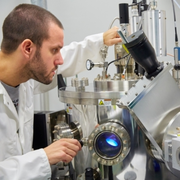Fabrication and characterization of magnetic thin films and multilayers, PhD Thesis by Lorenzo Fallarino
Lorenzo Fallarino, Pre-doctoral Researcher at the Nanomagnetism Group at CIC nanoGUNE, received his PhD at the University of the Basque Country (UPV/EHU) after the defense of his thesis project on Thursday 26th of January 2017. His research work, entitled “Fabrication and characterization of magnetic thin films and multilayers", has been developed under the supervision of Dr. Andreas Berger, nanoGUNE’s Research Director and Nanomagnetism group leader.
An international committee including leading researchers in the field was selected to assess the research project:
- Dr. Miren Nerea Zabala Unzazu (UPV/EHU)
- Dr. Stèphane Mangin (Institut Jean Lamour – Université de Lorraine)
- Dr. Luis Alberto Morellón Alquézar (Universidad de Zaragoza)
The defense consisted of a presentation by the candidate on the main aspects of the Ph.D. thesis project followed by an extended discussion based upon the questions that each one of the members of the committee raised in relation to the research work that has been carried out by Lorenzo Fallarino during his PhD studies. After its final deliberation, the committee decided to award the candidate the Doctor Degree with the highest mention existing at UPV/EHU (cum laude).

Lorenzo Fallarino at the Physical Characterization Laboratory, at CIC nanoGUNE.
After the defense, we asked Dr. Lorenzo Fallarino to explain us a bit more about his project:
Which was the subject of your thesis?
My main work involved designing, fabricating, and characterizing magnetic epitaxial alloy thin films and multilayers, driven by my interest to engineer their magnetic properties towards potential future technological application. Along with this, I also contributed to a couple of other projects, like the study of weak delocalization in graphene or spin transport properties of silver (Ag).
Why did you choose this subject?
I fell in love with magnetism during my master studies (M.Sc.), when I was studying propagating spin waves excited by microwaves. Magnetism is definitely a very fascinating field of studies, and it seemed to me as being both challenging and exciting.
Which methodology/techniques did you use?
I have used a number of different experimental techniques: metal and oxide sputtering in ultra-high vacuum chambers for the fabrication of the epitaxial samples; X-ray diffraction/reflection for the structural characterization; VSM and SQUID magnetometry to measure the magnetic signals (in magnetic fields up to 7 T and temperatures down to 1.8 K), as well as Polarized Neutron Reflectometry (PNR) at the NIST Center for Neutron Research in Maryland. I must say that organizing and performing PNR experiments on samples that I devised and fabricated has been the most excited part of the work.
Which have been the main conclusions?
We have demonstrated that the effective Curie temperature of a ferromagnetic alloy thin film can be continuously varied as a function of depth via a corresponding compositional profile, even down to the nanometer length scale. At the same time we have identified the nature of three distinct magnetic phases that form the phase diagram of ferromagnetic thin films with perpendicular magnetization orientation. Furthermore, the work of this thesis has provided experimental evidence that the reversal of the antiferromagnetic order parameter in thin films of magnetoelectric antiferromagnets by pure magnetic means is possible when these types of materials are geometrically confined in thin films.
What could be the contribution of your research for present or future nanotechnologies?
The studies I conducted achieved a better understanding of the influence of crystallographic order, composition and thickness onto the magnetic properties of metallic and oxide thin films and multilayers, which are relevant for a number of future applications in nanotechnologies.
How do you feel now that you have finished the thesis?
I feel happy and relieved that I managed to bring my thesis work to a successful conclusion, but at the same time a bit of sadness entered as well, because it also means an end to many fruitful professional collaborations and saying good bye to people that I enjoyed working with.
